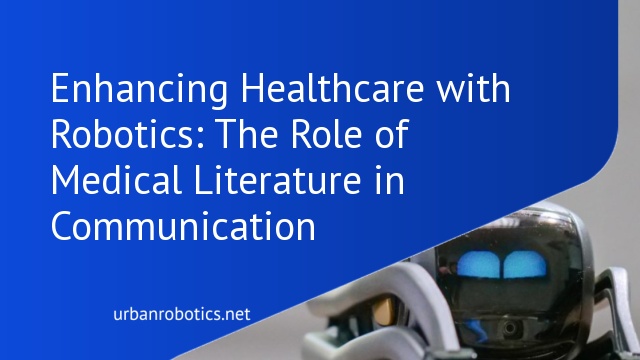The Role of Medical Literature in Healthcare
Medical literature guides healthcare communications, especially integrating robotics. It ensures technology aligns with patient care protocols, enhancing clinical outcomes.
Importance of Medical Literature
Medical literature provides the foundation for evidence-based practice, ensuring reliable information. It standardizes procedures and minimizes errors. For example, clinical guidelines from studies inform robotic surgery protocols. Medical reviews and case reports assess the effectiveness and safety of robotic systems. This rigor ensures that healthcare providers make informed decisions.
Evolution of Medical Literature
Medical literature has evolved from text-heavy journals to digitized databases, improving access. Early publications focused on basic research, while modern resources include interactive platforms like PubMed and Cochrane Library. Innovations in digital archiving have streamlined access to real-time data. Today’s literature incorporates multimedia, making complex information more comprehensible. This evolution supports healthcare professionals in keeping up with rapid advancements in robotic technology.
Integration of Robotics in Healthcare
The integration of robotics in healthcare has transformed patient care and clinical processes. Our focus will be on advances in medical robotics and the benefits these systems bring to healthcare.
Advances in Medical Robotics
Significant advances in medical robotics have emerged over the past decade. Surgical robots like the da Vinci Surgical System enable precise, minimally invasive procedures, reducing recovery time. Autonomous robots perform routine tasks, such as medication delivery, reducing staff workload. Additionally, robotic prosthetics now offer enhanced mobility and functionality. These developments, backed by medical literature, continuously improve healthcare delivery.
Benefits of Robotics in Healthcare
Robotic systems offer multiple benefits in healthcare. Enhanced precision in surgical procedures minimizes human error and improves patient outcomes. Automated robots alleviate the workload of healthcare staff by managing routine tasks like medication and supply delivery. Rehabilitation robots assist in patient recovery, offering personalized therapy sessions. These benefits highlight the importance of integrating robotic technology, guided by medical literature, to advance patient care effectively.
Communication Through Robotics
Robotics enhance communication in healthcare by facilitating interactions between patients and providers and streamlining medical processes. Utilizing robots in these scenarios supports accuracy, efficiency, and improved patient outcomes.
Enhancing Doctor-Patient Interaction
Robots improve doctor-patient interactions by enabling real-time, remote consultations and monitoring. These systems help address communication barriers, offering translation services and real-time data sharing to ensure clear conversations. For instance, telepresence robots allow doctors to visit patients in different locations without physical presence, enhancing access to healthcare services.
Streamlining Medical Processes
Robotic systems streamline medical processes by automating routine tasks and improving workflow efficiency. Medication dispensing robots reduce errors, ensuring patients receive correct dosages. Additionally, robots assist in inventory management, updating records, and handling logistics, freeing healthcare professionals to focus more on patient care tasks.
Medical Literature and Robotics Synergy
Medical literature and robotics work synergistically in healthcare communication to enhance patient outcomes and streamline clinical practices. This collaboration integrates evidence-based research with cutting-edge robotics technology.
Case Studies and Research Findings
Numerous case studies and research findings demonstrate the impact of this synergy. For instance, a 2022 study published in the Journal of Robotic Surgery reported that surgeries performed using robotic systems had 30% fewer complications compared to traditional methods. Another study in the New England Journal of Medicine highlighted the effectiveness of robotic rehabilitation in stroke patients, showing a 15% improvement in recovery times. These findings underscore the critical role of medical literature in validating the efficiencies introduced by robotics in healthcare.
Future Trends and Predictions
Medical literature continues to forecast promising future trends in robotic healthcare. Researchers predict that by 2030, robotic systems will be integral to over 50% of surgical procedures, as reported in a 2021 Global Health Journal article. Moreover, advancements in AI-driven diagnostic tools are expected to revolutionize disease detection and management, as outlined in recent publications. We anticipate a continual enhancement in the performance of healthcare robotics, providing increasingly personalized patient care based on ongoing research results.
Challenges and Limitations
Integrating robotics in healthcare offers transformative potential, but several challenges and limitations accompany this evolution.
Technical and Ethical Concerns
Robotic systems, while advanced, often face technical issues like system malfunctions and integration complexities with existing healthcare infrastructure. High initial costs and maintenance expenses can limit widespread adoption. Ethical concerns also arise, centering on patient data privacy and the implications of decision-making by robotic systems. Ensuring robotics align with ethical standards in patient care is crucial yet challenging.
Overcoming Barriers
Addressing these challenges requires a multi-faceted approach. Investing in advanced training for healthcare professionals can mitigate technical issues. Leveraging robust cybersecurity measures can enhance patient data protection. Policy development and regulatory frameworks must evolve to address ethical concerns, ensuring responsible use of robotics. Collaborative efforts between technology developers, healthcare providers, and policymakers are necessary to foster an environment conducive to overcoming these barriers.
Conclusion
Embracing robotics in healthcare offers remarkable potential for enhancing patient care and streamlining clinical processes. Medical literature plays a crucial role in this integration by providing evidence-based guidelines and real-time data access. While the benefits of robotic systems are clear, including improved surgical precision and reduced staff workload, we must address the challenges they present.
Technical malfunctions and high costs can impede widespread adoption, and ethical concerns about data privacy and robotic decision-making require careful consideration. To fully realize the advantages of robotics in healthcare, we need advanced training, robust cybersecurity measures, and well-defined policies. By working together, technology developers, healthcare providers, and policymakers can create a supportive environment for the responsible use of robotics in healthcare.





